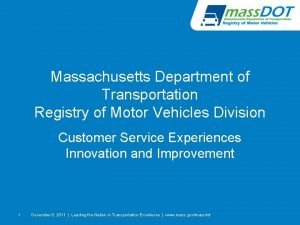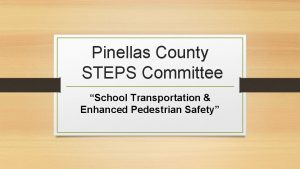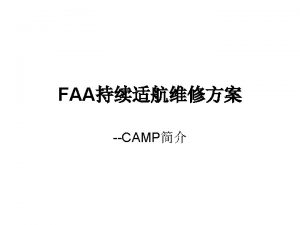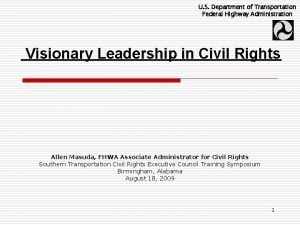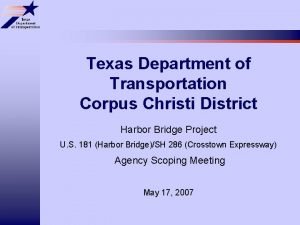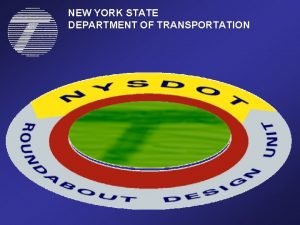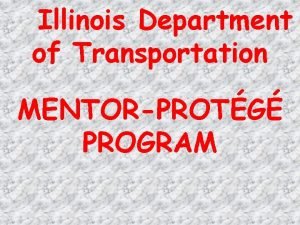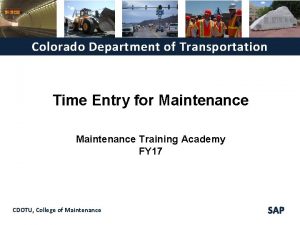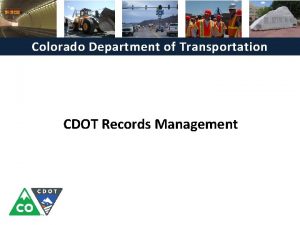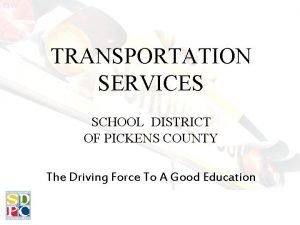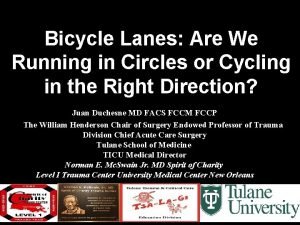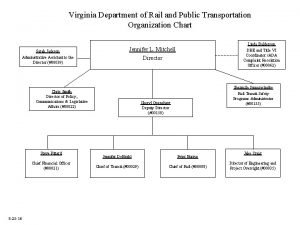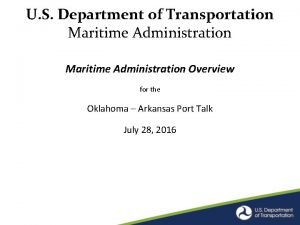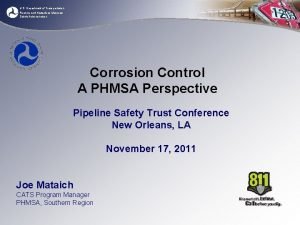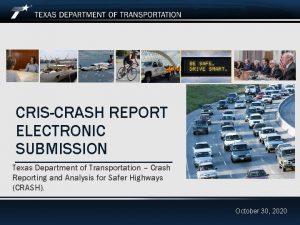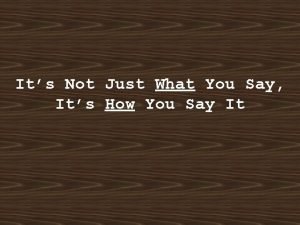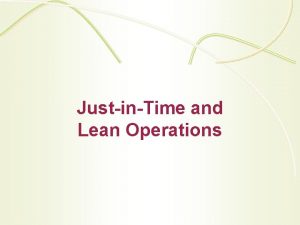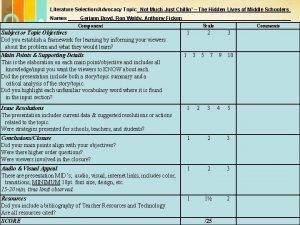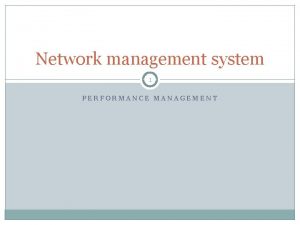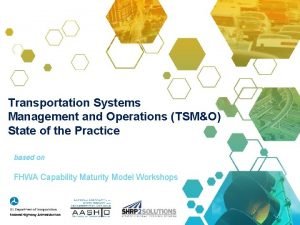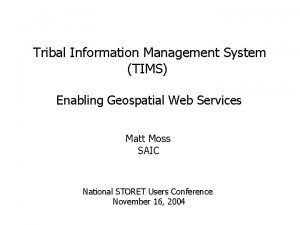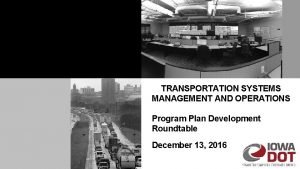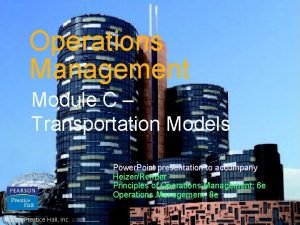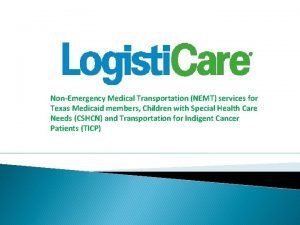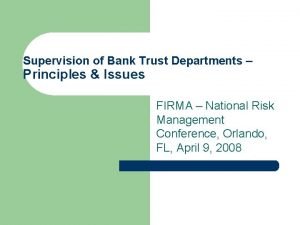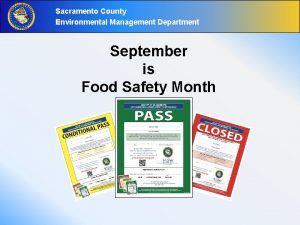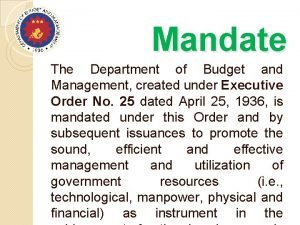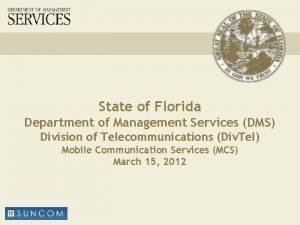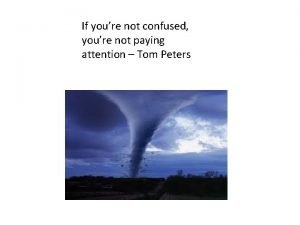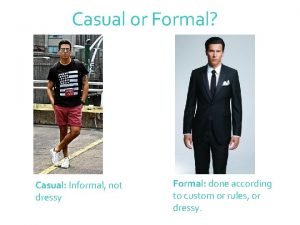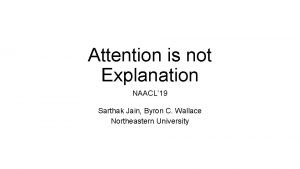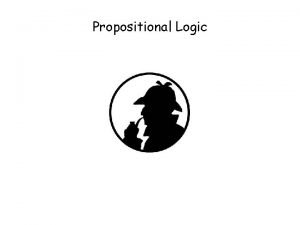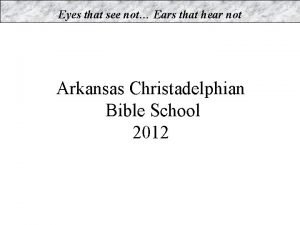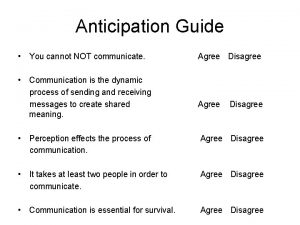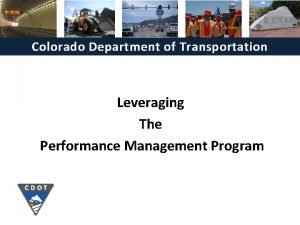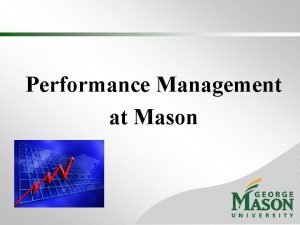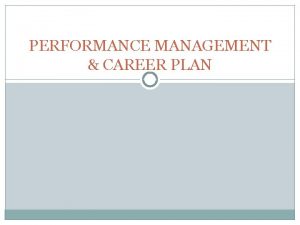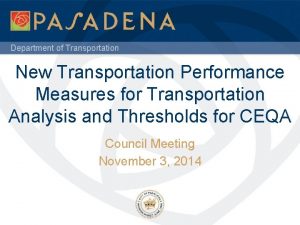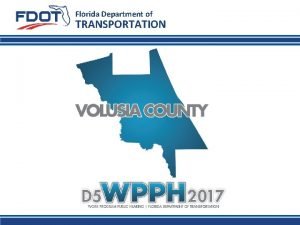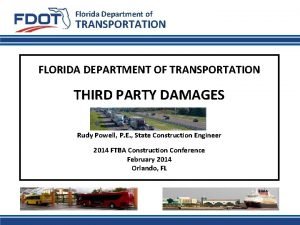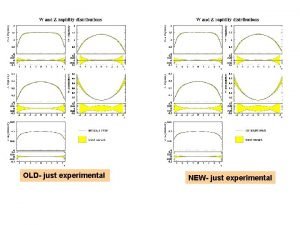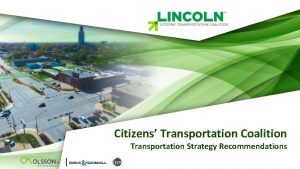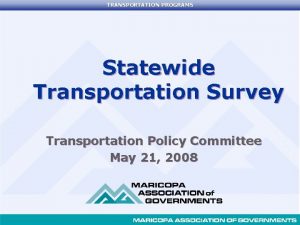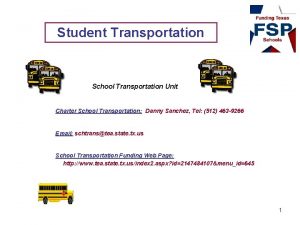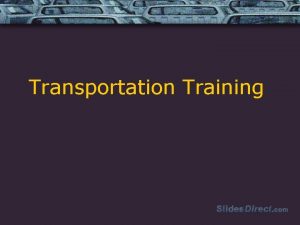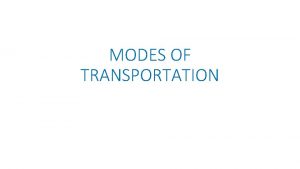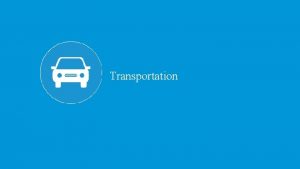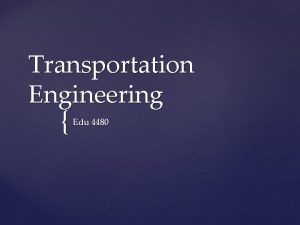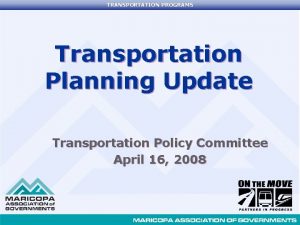Colorado Department of Transportation Performance Management Not Just



























































- Slides: 59

Colorado Department of Transportation Performance Management: Not Just the Evaluation

Course Agenda • • • Learning Logistics Section 1 – Performance Management Section 2 – Performance Planning Section 3 – Giving Performance Evaluations Section 4 – Ongoing Communication Conclusion Colorado Department of Transportation Slide 4

Course Learning Objectives At the end of this course, you should be able to: Describe what Performance Management is at CDOT and your role Create Performance Management goals for employees and set expectations Give performance evaluations and provide feedback to the employee Describe when to use an Individual Development Plan (IDP) and the Performance Improvement Plan (PIP) • Describe the importance of ongoing communication throughout the performance plan year and how to prepare and conduct the meetings • Identify when there are performance issues with employees and how to take action at the lowest possible level • • Colorado Department of Transportation Slide 5

Participant Introductions Please take a moment to share: • Your name • Your role within CDOT • Your expectations of this course Colorado Department of Transportation Slide 6

Learning Logistics • A break is not typically provided for a two hour class • Classroom participation is encouraged; ask, answer, and participate in the discussion • Please actively participate in course exercises as they provide you an opportunity to practice • The Parking lot is used to capture questions for in-class follow-up Colorado Department of Transportation Slide 7

Your Contributions to Learning • Please respect the other participants by silencing your cell phones • Focus on the course, please use the Internet and email over lunch and break times • Please delay your side conversations until break times • Attend the entire course to obtain credit for successful course completion Colorado Department of Transportation Slide 8

Course Agenda • • • Learning Logistics Section 1 – Performance Management Section 2 – Performance Planning Section 3 – Giving Performance Evaluations Section 4 – Ongoing Communication Conclusion Colorado Department of Transportation Slide 10

Section 1 Learning Objectives At the end of this section, you should be able to: • Describe what Performance Management is and how it is conducted at CDOT • Identify the Performance Management program requirements (State and CDOT) • Recognize the difference between Performance Management and Performance Evaluation • Identify the roles in the Performance Management process Colorado Department of Transportation Slide 11

Terms and Concepts • Performance Management – Is about the people at CDOT, communication, dialogue and working together to accomplish our goals and objectives (not about forms or forcing people to produce). • Performance Evaluation – The process by which an individual’s work performance is assessed, evaluated and supported. Colorado Department of Transportation Slide 12

Why Performance Management? The CDOT Leadership Forum conducted in the Fall of 2015 set forth the expectation to use the Performance Management process as a tool to be a leader. Leadership is: • • • Caring about people and being a useful resource for them Being present for people and being your best and most authentic self Creating a place in which people can do good work and find meaning in that work CDOT Leadership Forum 2015

What is Performance Management? Training Coaching Meetings Performance Management Evaluation Development Setting Expectations and Goals Colorado Department of Transportation • Ongoing communication between you and the Employee • How employees become engaged in their work • Working with employees to improve their abilities • Documenting expectations • Focus on connecting the employee’s role to the organization Slide 14

Performance Management Focused on: - Planning - Dialogue - Present and Future - Resolving issues - Cooperative Colorado Department of Transportation Not on: - Evaluation - Monologue - Past - Blaming - Negative Slide 15

Performance Management Requirements CDOT and State Performance Management Requirements: • Employee must have a performance plan within 30 days of hire • Employee and Supervisor should meet regularly • Three signatures (Employee, Supervisor and Reviewer) are required • Final reviews due by March 31 st each calendar year • The planning meeting should include a discussion of: • • Department goals Work Unit plan Employee’s Position Description Questionnaire Employee’s goals and competency expectations • Evaluated using a five tiered performance rating scale converted to state’s three tiered Colorado Department of Transportation Slide 16

Difference Between Performance Management and Performance Evaluation Performance Management is about the employee and supervisor exchanging views on performance. Performance Management • • • Identifies and measures performance Focuses on future development Describes what you are doing to help Colorado Department of Transportation Performance Evaluation • • • Evaluates employee performance Focuses on the past actions of the Employee Reacts to what was done in the past Slide 18

Roles in Performance Management Colorado Department of Transportation Slide 19

Check Your Knowledge 1. What document focuses on past actions of the employee? • Performance Evaluation 2. The ______ reviews the supervisor’s employee rating and resolved any disputes. • Appointing Authority Colorado Department of Transportation Slide 20

Course Agenda • • • Learning Logistics Section 1 – Performance Management Section 2 – Performance Planning Section 3 – Giving Performance Evaluations Section 4 – Ongoing Communication Conclusion Colorado Department of Transportation Slide 22

Section 2 Learning Objectives At the end of this section, you should be able to: • Describe the role of the supervisor in establishing performance expectations and serving as a leader • Engaging employees in the performance management process • Describe how to prepare for the performance evaluation • Understand how to create a S. M. A. R. T. Goal Colorado Department of Transportation Slide 23

Terms and Concepts • Performance Expectations – One or more short-term objectives related to the specific job related skills of an employee or to a similar skill set the employee is looking to acquire • Competencies – Job related skills or abilities that are used by an employee to successfully perform the duties of their position • S. M. A. R. T Goal – a mnemonic used to create a high quality goal. It stands for Specific, Measurable, Achievable, Relevant and Time. Bound • Performance Documentation Form – A form used to document both positive performance and performance that needs improvement Colorado Department of Transportation Slide 24

The Leadership Role of the Supervisor The role of the supervisor is to: • Connect the daily tasks of their employee(s) to CDOT’s mission, vision and values • Document examples of performance (both positive and negative) • Coach employees on their development throughout the Performance year • Provide meaningful and specific feedback • Complete all performance planning meetings and documentation by the stated deadlines Colorado Department of Transportation Slide 25

Engaging Employees in the Performance Management Process Setting Clear Goals by • Clearly defining what is expected of the employee • Ensuring employee has everything they need for success • Connecting the employee’s position to CDOT’s success Engage Top Performers by: • Create goals that allow them to teach others • Provide specific feedback • Allow them to learn through special assignment Engage Unmotivated Employees by: • Explain why • Create small changes with a big impact • Provide specific feedback Colorado Department of Transportation Slide 26

Communication and Goals are created collaboratively: • Complete the Performance Planning Checklist to make sure you cover everything • Provide information about CDOT • Communicate what the employee will be evaluated on • Explain you will also be meeting with the employee two other times • Midyear progress review • Final review Colorado Department of Transportation Slide 28

Creating a S. M. A. R. T. Goal S. M. A. R. T. goals are used to: • Develop new skills the employee needs for their: • • • Current position Future growth into another position Focus an employee on performance needed by: • • CDOT The employee Colorado Department of Transportation Slide 29

Exercise When crafting a S. M. A. R. T. Goal: • Use concise language • Keep it relevant to the position/employee • Be positive Using the S. M. A. R. T. Goals Template: 1. Write out your initial goal 2. Modify your goal based on the S. M. A. R. T. criteria 3. Review and rewrite your goal Colorado Department of Transportation Slide 30

Where do I Start? Colorado Department of Transportation Slide 31

Documenting Observations Here are two options to document observations: The PDF: • Desirable and less than desirable behavior • Not part of formal discipline process • Exceptional Behavior • Specific actions by the employee Colorado Department of Transportation The Performance Log: • Documents everyday actions • Not part of the formal discipline process • Documents everyday occurrences Slide 33

Check Your Knowledge 1. What are some key elements to keeping employees engaged during the performance management process? • • Specific feedback Clear expectations 2. S. M. A. R. T is a mnemonic that stands for: • A goal that is: Specific, Measurable, Achievable, Relevant and Time-Bound Colorado Department of Transportation Slide 34

Course Agenda • • • Learning Logistics Section 1 – Performance Management Section 2 – Performance Planning Section 3 – Giving Performance Evaluations Section 4 – Ongoing Communication Conclusion Colorado Department of Transportation Slide 36

Section 3 Learning Objectives At the end of this section, you should be able to: • Explain the role of the supervisor or manager in conducting the Performance Evaluation • Describe how to prepare for the performance evaluation meeting • Describe when to use an Individual Development Plan • Explain how to provide constructive feedback • Describe what actions to take if the employee is angry, non-responsive or upset • Explain how to rate an employee’s performance Colorado Department of Transportation Slide 37

Terms and Concepts • Performance Evaluation – The process by which an individual’s work performance is assessed, evaluated and supported. • Individual Development Plan (IDP) – The process by which the employee is coached to develop new skills Colorado Department of Transportation Slide 38

Performance Management Process Communication between you and the employee Performance Planning Midyear Review Final Rating Performance Management Process Rating Colorado Department of Transportation Final Review Performance ratings and meetings occur twice a year: • Midyear Progress Review • provide counseling and feedback • Final Rating • A review performance • Discussion of the performance goals and competencies Note: the final performance rating is not to be discussed until it has been approved by the reviewer Slide 39

The Role of the Supervisor in Performance Management During the Midyear and Final Performance Review the supervisor: • Prepares for the review by completing the Review Checklist • Discusses employee progress • Documents the results of the meeting • Follows up with any additional documents • Answers questions from the 2 nd level reviewer • Ensure all deadlines are met Colorado Department of Transportation Slide 41

Gather the Details Prior to rating an employee review: • The competencies descriptions and goals • The PDQ • Notes on performance from your notebook • Emails/conversations from others about performance Colorado Department of Transportation Slide 42

Connect with your Employees Be approachable • Be someone they want to talk to Listen to your employees • Understand their frame of reference • Ask good questions Communicate with your employee and your supervisor • Tell them what’s happening or not happening Colorado Department of Transportation Slide 43

Difference Between Employee Development and Employee Improvement focuses on addressing past behavior, Development is planning for the future. Employee Improvement Employee Development • • • Based on future development Focused on needed skills Developments new behaviors Colorado Department of Transportation • • • Based on past behavior Focused on changing past actions Changes undesirable behaviors Slide 44

Development Plan When creating an Individual Development Plan: 1. Establish a reason and motivation • To promote to the next level 2. Describe needs to be learned • Identify the competencies 3. Identify development actions 4. Implement the plan and follow-up • • Employee owns the plan Supervisors mentors and supports Colorado Department of Transportation Slide 45

Providing Feedback • Actionable • Balanced • Constructive Candid Jobrelated Specific Effective feedback Action focused Positive Timely / Frequent Colorado Department of Transportation Slide 46

What to do if the employee is… Angry Non-responsive • Discuss only the • Engage with the employee performance of the by asking questions about employee and not their the action feelings • Allow the employee some • Acknowledge the breathing room to employee is upset reschedule the • Ask the employees for appointment details about why they are • Listen actively when the upset employee speaks • Ask for help in understanding why the person is angry • Change the meeting to another time after a cooling off period Colorado Department of Transportation Defensive • Be direct with the employee • Provide specific examples of the behavior • Acknowledge the employee viewpoint and redirect to policy • Do not ask questions about the behavior Slide 47

Step 2 - Rating the Employee Level 3 Exceptional (*****) 5 stars Level 2 Successful or Expected Performance (2, 3 or 4 Stars) 2+ **** 2** When rating remember: • An employee may excel in one are and may do poorly in another • Not evaluated based on other employees • May have a 2+ or 2 - rating • Performance is based on how well the employee performs their job based on PDQ Level 1 Needs Improvement (*) 1 star Colorado Department of Transportation Slide 48

Step 3 – Define Expectations (2+ and 2 -) 2 2 Occasionally Exceeds Employee performs occasional exceptional work with the majority of work being as expected Colorado Department of Transportation Occasionally Meets Employee performance is poor at times with the majority of work being as expected Slide 49

Exercise Match the statement to Level of performance • Matt has complied with all of his safety training • Christine is viewed as a safety resource by her peers • John has occasionally been coached by his peers on safety • Beverly had several minor safety issues such as not wearing her vest in traffic and reported for talking on her cell phone while driving • Mark has complied with all safety standards and has occasionally worked to explain safety procedures Colorado Department of Transportation Slide 50

Check Your Knowledge 1. If you perform work as expected, with occasional exceptional work, you will receive a _____ rating. • 2+ 2. Your feedback should be based on the behavior and not the _____. • Person 3. What are the ABC components of constructive feedback? • • • Actionable Balanced Constructive Colorado Department of Transportation Slide 51

Course Agenda • • • Learning Logistics Section 1 – Performance Management Section 2 – Performance Planning Section 3 – Giving Performance Evaluations Section 4 – Ongoing Communication Conclusion Colorado Department of Transportation Slide 53

Section 4 Learning Objectives At the end of this section, you should be able to: • Describe why communication is important (workplace changes, priorities, information and problem identification) • Identify the types of Ongoing Communication required (striking the balance, not all the same) • Describe ways to be effective in communications • Identify when you may have a performance issue • Recognize when to use a Performance Improvement Plan (PIP) Colorado Department of Transportation Slide 54

Terms and Concepts • Ongoing Communication – The process where there is continuous and ongoing communication between the employee and their supervisor throughout the performance plan year • Performance Improvement Plan (PIP) – The process by which the Supervisor works with the employee to correct performance and refocus on employee success. An informal tool to assist employee improve their job performance. Colorado Department of Transportation Slide 55

Ongoing Communication and Performance Breaking Stopping Reaction Ongoing Performance Communication allows the employee to react before issues occur. Examples include: • Weekly meetings • One-on-one communication • Coaching • Minor corrections based on observation • Discussion of goals • Emails about changes • Hallway chats Colorado Department of Transportation Slide 56

Interim Communication Interim rating occurs when there is a: • Transfer, promotion or demotion (requires a new performance plan) • New supervisor • Needs improvement rating* * Requires a new performance plan Colorado Department of Transportation Slide 57

Communication and Leadership When asked about what prevented an employee’s supervisor from being effective the top three responses were: • Not recognizing employee achievement • Not giving clear directions • Not making time to meet with the employee *Source Interact/Harris poll Colorado Department of Transportation Slide 58

How to be Effective Recognizing Employee Achievement: • If you see something say something • Tie it to CDOT Values • Document it! • Use recognition programs Providing Clear Directions: • Give instructions not orders • Emphasize the key points • Communicate a timeline • Adjust based on experience Make Time to Meet with Employees: • Understand the feedback requirements • Have questions to ask the employee ready • Understand what is communication for your employee Colorado Department of Transportation Slide 59

Identifying the Signs of Poor Performance Signs of poor performance include: • Relying on others too much • Poor work quality • Violating Policy and/or Rules • Ignoring CDOT values • Missing deadlines • Not working well with other or affecting the others • High absentee rate • Employee is late or leaves early Colorado Department of Transportation Slide 61

Performance Improvement The PERFORMANCE IMPROVEMENT PLAN (PIP) is: • • • Created if an employee receives a needs improvement (rating of 1) for a goal or competency An informal way to document specific behaviors When the action does not rise to the level of a corrective action Active for a period of 90 days Must be signed by the employee Colorado Department of Transportation Slide 62

Performance Management and Progressive Discipline Performance issues can be addressed through: • Performance management • Progressive discipline Disciplinary Action Corrective Action PDF / PIP Documentation of Counseling Coaching Setting Expectations and Goals Colorado Department of Transportation Slide 63

Check Your Knowledge 1. • • • What can prevent a supervisor from being effective? Not recognizing employee achievement Not giving clear directions Not making time to meet with the employee 2. When you recognize you may need to address a performance issue that does not rise to the level of a corrective action, what document would you use? • Performance Improvement Plan Colorado Department of Transportation Slide 64

Course Agenda • • • Learning Logistics Section 1 – Performance Management Section 2 – Performance Planning Section 3 – Giving Performance Evaluations Section 4 – Ongoing Communication Conclusion Colorado Department of Transportation Slide 66

Conclusion You should now be able to: Describe what Performance Management is at CDOT and your role Create Performance Management goals for employees and set expectations Give performance evaluations and provide feedback to the employee Describe when to use an Individual Development Plan (IDP) and the Performance Improvement Plan (PIP) • Describe the importance of ongoing communication throughout the performance plan year and how to prepare and conduct the meetings • Identify when there are performance issues with employees and how to take action at the lowest possible level • • Colorado Department of Transportation Slide 67

Key Takeaways How to facilitate continuous engagement and improvement: • • Keep a performance log for each employee Be aware of employee concerns Create the right atmosphere on the review day Cite good work first and then address poor performance Reset your attitude if you need to Pose great questions at the meeting to spur deep thinking Acknowledge mistakes Inspire/motivate others in difficult times Colorado Department of Transportation Slide 68

Where Can I Get Help – People? For additional assistance contact: • Susan Maxfield: HR Business Partner - Email: Susan. Maxfield@state. co. us • Beverly Wyatt: HR Business Partner - Email: Beverly. Wyatt@state. co. us • Performance Management page on Intranet • • Instructional Video and Written Instructions Milestone Dates for Performance Plan Year Performance Management Tools page Performance FAQ page Colorado Department of Transportation Slide 69

Where Can I Get Help – People? For additional assistance contact: Region Name Email Phone One Kathy M. Williams kathy. williams@state. co. us 303 -757 -9386 Two Mary Vigil mary. vigil@state. co. us 719 -546 -5432 Three Chip Brazelton chip. brazelton@state. co. us 970 -683 -6210 Four Juliet Sheets juliet. sheets@state. co. us 970 -350 -2156 Five Jason Benally jason. benally@state. co. us 970 -385 -1403 Colorado Department of Transportation Slide 70

Questions? Colorado Department of Transportation Slide 71
 Just right scale
Just right scale Massachusetts department of transportation
Massachusetts department of transportation Montana department of transportation
Montana department of transportation Pinellas county school transportation
Pinellas county school transportation Department of transportation
Department of transportation Department of transportation
Department of transportation Maricopa county department of transportation
Maricopa county department of transportation Texas department of transportation corpus christi
Texas department of transportation corpus christi Latham traffic circle
Latham traffic circle Department of transportation
Department of transportation Seminole transportation
Seminole transportation Department of transportation
Department of transportation Department of transportation
Department of transportation Pickens school bus office
Pickens school bus office Department of transportation
Department of transportation Virginia department of rail and public transportation
Virginia department of rail and public transportation Us department of transportation maritime administration
Us department of transportation maritime administration Department of transportation
Department of transportation Cris crash select agency
Cris crash select agency Who was the first person to arrive at juliet's tomb
Who was the first person to arrive at juliet's tomb Performance levels
Performance levels Behaviorally anchored rating scales
Behaviorally anchored rating scales Sudden and violent but brief; fitful; intermittent
Sudden and violent but brief; fitful; intermittent It’s not just what you say, it’s how you say it.
It’s not just what you say, it’s how you say it. Cm9iysdxagc -site:youtube.com
Cm9iysdxagc -site:youtube.com Characteristics of just-in-time partnerships do not include
Characteristics of just-in-time partnerships do not include Not just anyone
Not just anyone Not just bingo march
Not just bingo march Not much just chillin summary
Not much just chillin summary Never_used
Never_used Sample kpi for project engineer
Sample kpi for project engineer Performance management in network management
Performance management in network management What is transportation systems management and operations
What is transportation systems management and operations Transportation information management system tims
Transportation information management system tims Logisticare ri
Logisticare ri Transportation systems management and operations
Transportation systems management and operations Transportation model operations management
Transportation model operations management Texas nemt
Texas nemt 2018 jcids manual
2018 jcids manual Bank trust departments
Bank trust departments Sacramento county environmental health
Sacramento county environmental health Department of budget and management
Department of budget and management Collier growth management
Collier growth management Department management services dms
Department management services dms Scientific management
Scientific management Top management middle management first line management
Top management middle management first line management Top management middle management first line management
Top management middle management first line management If you're not confused you're not paying attention
If you're not confused you're not paying attention Informal-casual
Informal-casual Attention is not not explanation
Attention is not not explanation Too broad too narrow
Too broad too narrow Negation of if
Negation of if Love is not all it is not meat nor drink
Love is not all it is not meat nor drink Eyes that see and ears that hear
Eyes that see and ears that hear P ran
P ran If you can’t measure it, you can’t improve it
If you can’t measure it, you can’t improve it We will not be moved when everything around is shaking
We will not be moved when everything around is shaking Not a rustling leaf not a bird
Not a rustling leaf not a bird You cannot not communicate
You cannot not communicate Mark rockwell rockton software
Mark rockwell rockton software

